Zucchini pachadi is a spicy, tangy, nutrient packed South Indian chutney from Telugu cuisine. It goes well with plain rice, dosa and also tastes equally good as a spread for sandwiches and rolls.
Chutneys are an integral part of South Indian cuisine and Telugu cuisine is no exception. We make chutneys from pretty much all the vegetables. Though zucchini is not native to India, it looks and tastes similar to cucumber & ridge gourd.
Zucchini chutney recipe is inspired by beerakaya pachadi and sorakaya pachadi. In Britain, France and European countries, zucchini is courgette and if you are from that region, do try this Indian courgette chutney.
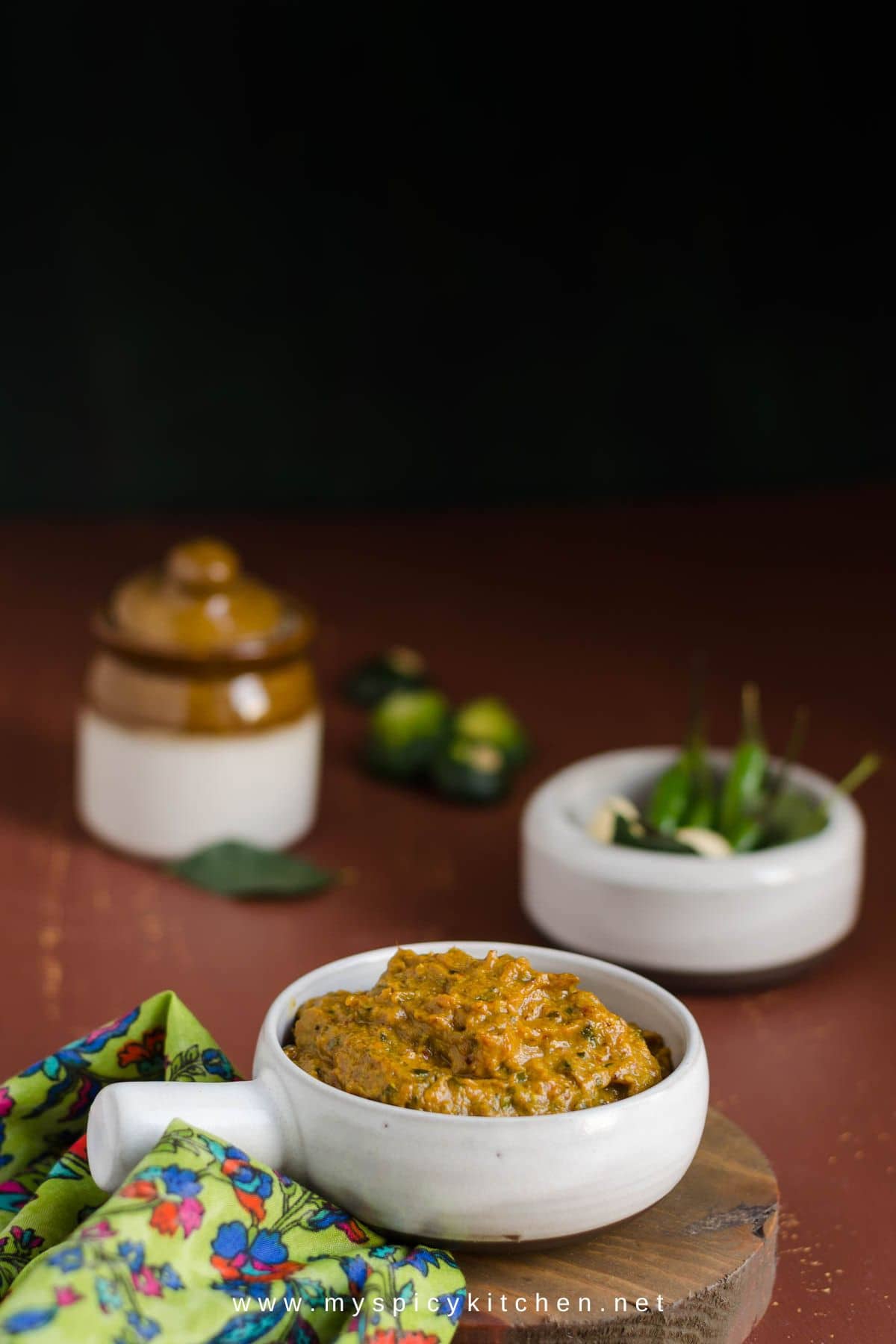
Jump to:
About the Recipe
Zucchini chutney recipe is similar to most vegetable chutneys; roast chilies, basic spices and the vegetable. Then grind it with tamarind and sesame seeds and/or peanuts.
In Telugu, chutney and pickle are both called pachadi and to differentiate between the two, it is prefixed with noorina pachadi or roti pachadi, depending on the region. Traditionally these chutneys are ground in a mortar pestle.
In Telangana it is noorina pachadi meaning a ground chutney and to be more precise, noorina is a term used to specify the process of grinding using a mortar pestle. And in Andhra, it is roti pachadi meaning a pachadi ground in a mortar.
Regardless of what it is called and how it is prepared, these pachadlu are delicious. If you are a fan of South Indian chutneys, try some of these chutneys; tomato pachadi, zucchini tomato pachadi, vankaya (brinjal) pachadi, cabbage pachadi and kobbari pachadi.
Ingredients

- Zucchini - use tender medium zucchini and do not peel it.
- Chilies - use a combination of green and red chilies. I normally use green chilies but for this recipe I use more red chilies for color. You can always use only green chilies as I have in zucchini tomato pachadi.
- Tamarind - use washed and soaked tamarind, and add it when cooking the zucchini. However, my preferred choice is homemade tamarind paste or concentrate. You can always substitute tamarind with lime juice.
- Nuts & Seeds - In Telangana region, sesame seeds are must in almost all the noorina pachadlu (plural of pachadi). Some people also add peanuts and I started adding it for protein quotient. Feel free to use both or either of these.
- Garlic - I am generous with garlic and feel free to adjust it to your liking and for a no garlic chutney, substitute with some asafetida.
- Tempering - Oil, cumin, fenugreek, curry leaves, turmeric and salt.
Instructions
It is an easy preparation. Roast chilies, nuts & seeds and spices separately. Then roast zucchini in the same pan and let cool. First grind the chilies, spices and nuts to a fine paste. Then add zucchini and coarsely grind.
Grinding Chutneys - Some Indian chutneys, specially vegetable chutneys taste better when coarsely ground and a mortar pestle does the best job. In a modern kitchen, I prefer using a food processor over a blender or a mixie.
Using a Food Processor - However, certain whole spices and nuts do not grind well in a food processor. Hence, when using a food processor for grinding chutneys, I use ground spices and nuts.
Grind dry red chilies and fenugreek seeds to a powder and similarly, powder roasted peanuts and sesame seeds. Use these in the preparation, rather than whole. Again, if using an Indian mixie, you skip the above steps and use whole ingredients as is.
SBS Instructions
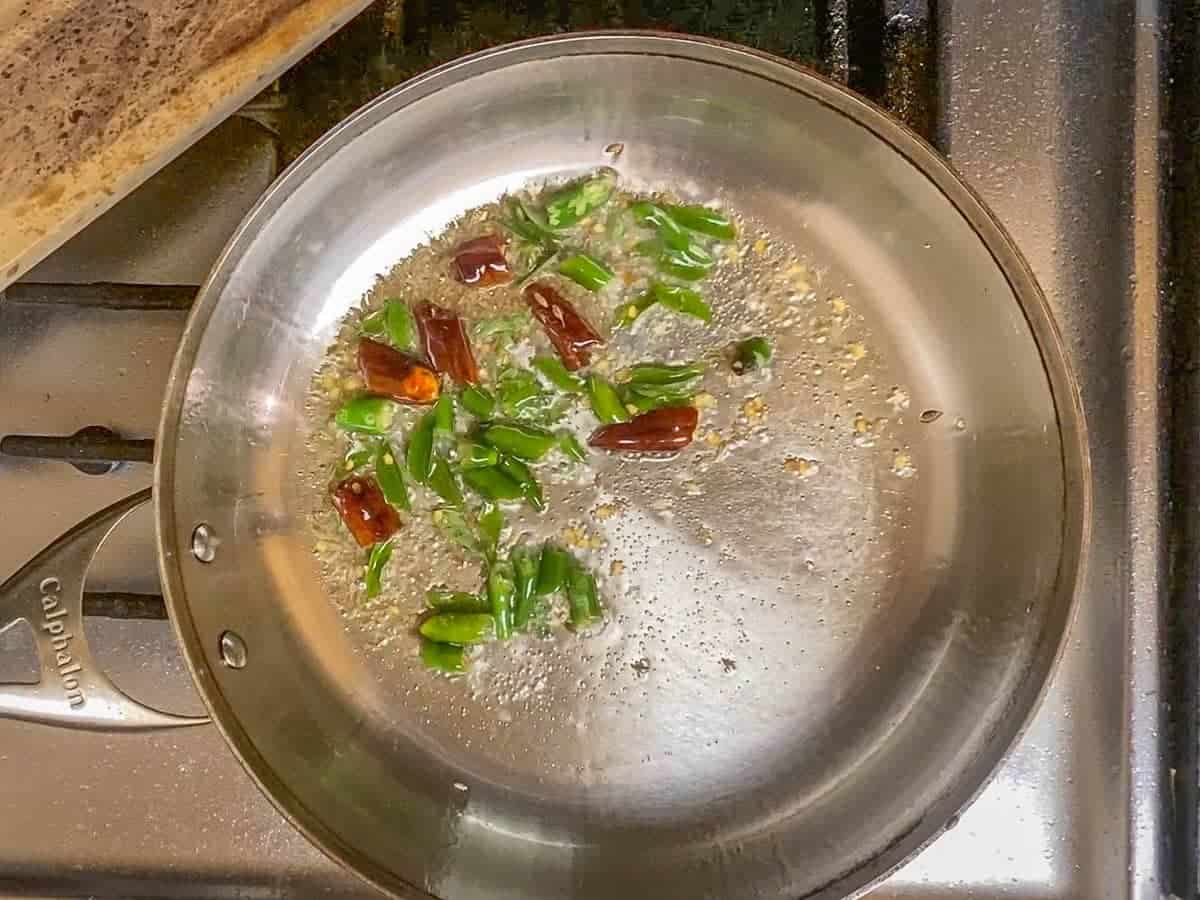
Step 1: Heat oil in a pan, roast red chili, green chilies, curry leaves and cumin seeds.
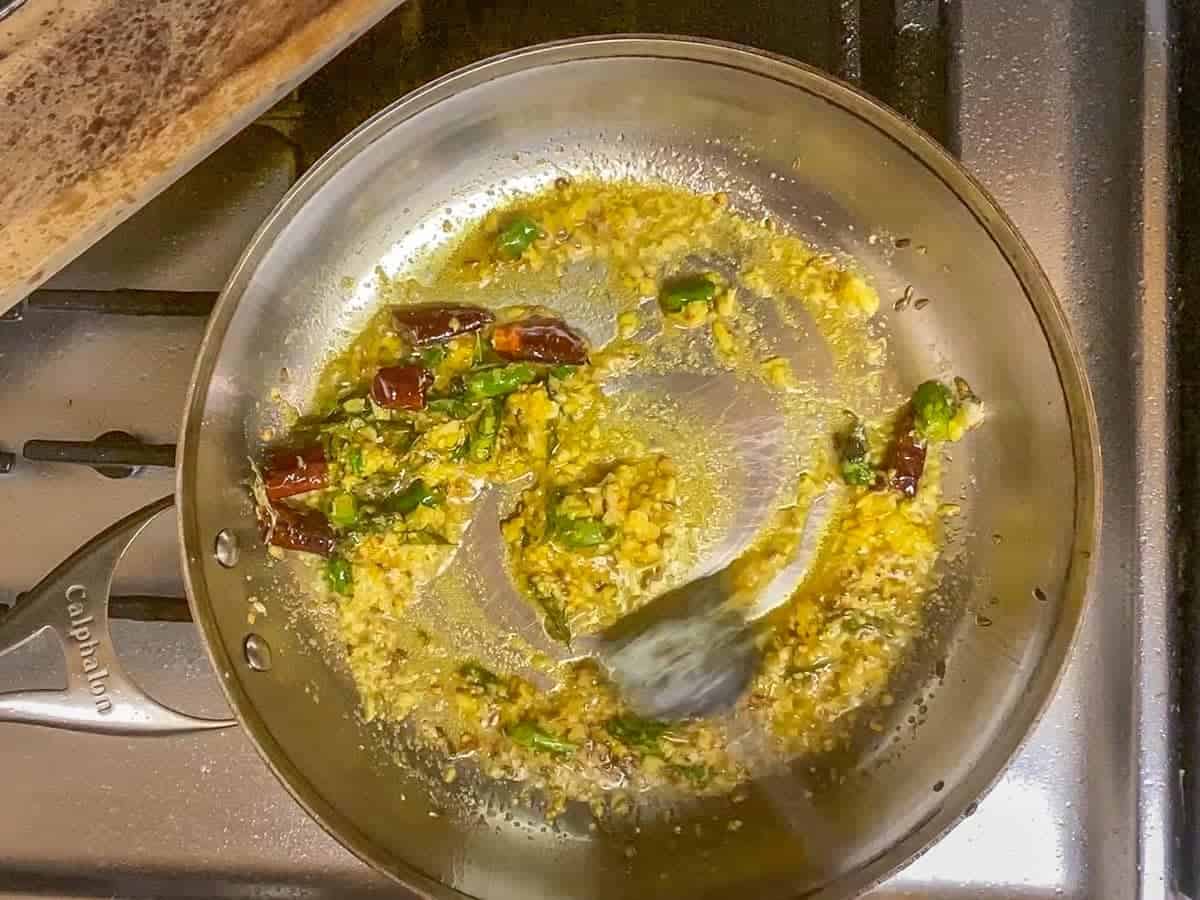
Step 2: Then add whole or crushed garlic, fenugreek powder, turmeric and salt. Mix well.
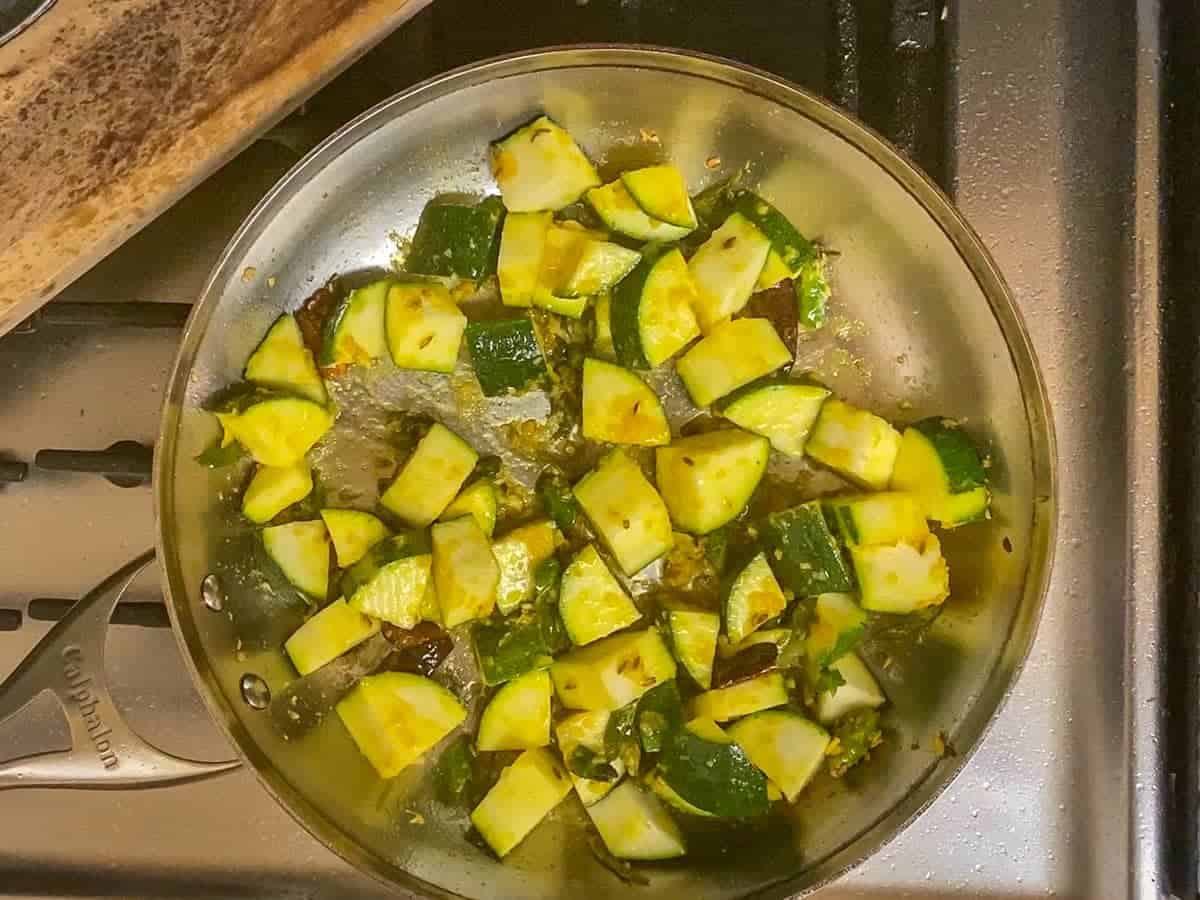
Step 3: Add washed, sliced zucchini pieces and mix well until spices coat the pieces.

Step 4: Add tamarind, cover and cook on medium flame until zucchini is soft and cook uncovered until all the liquids evaporate.
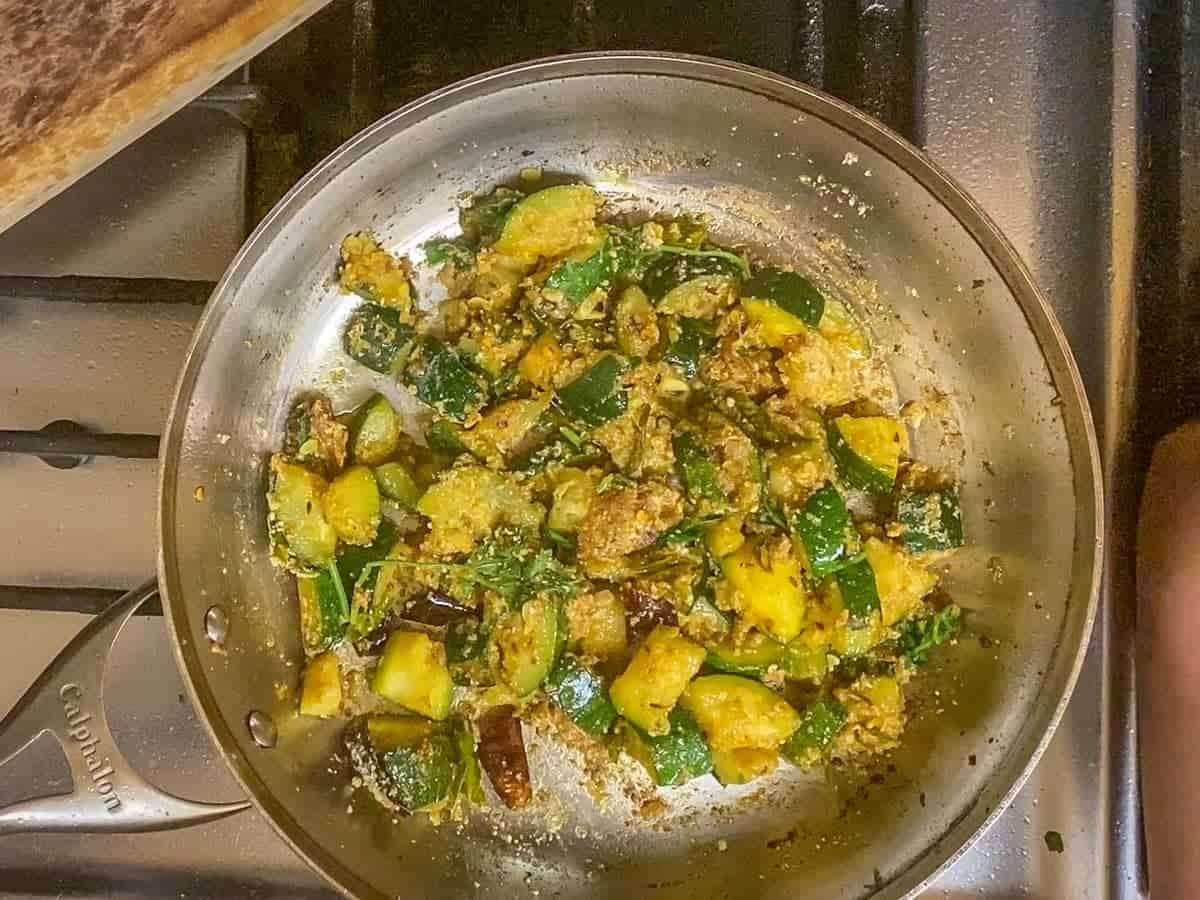
Step 5: Add cilantro, sesame and peanut powder and give a good stir. Let the mixture cool.
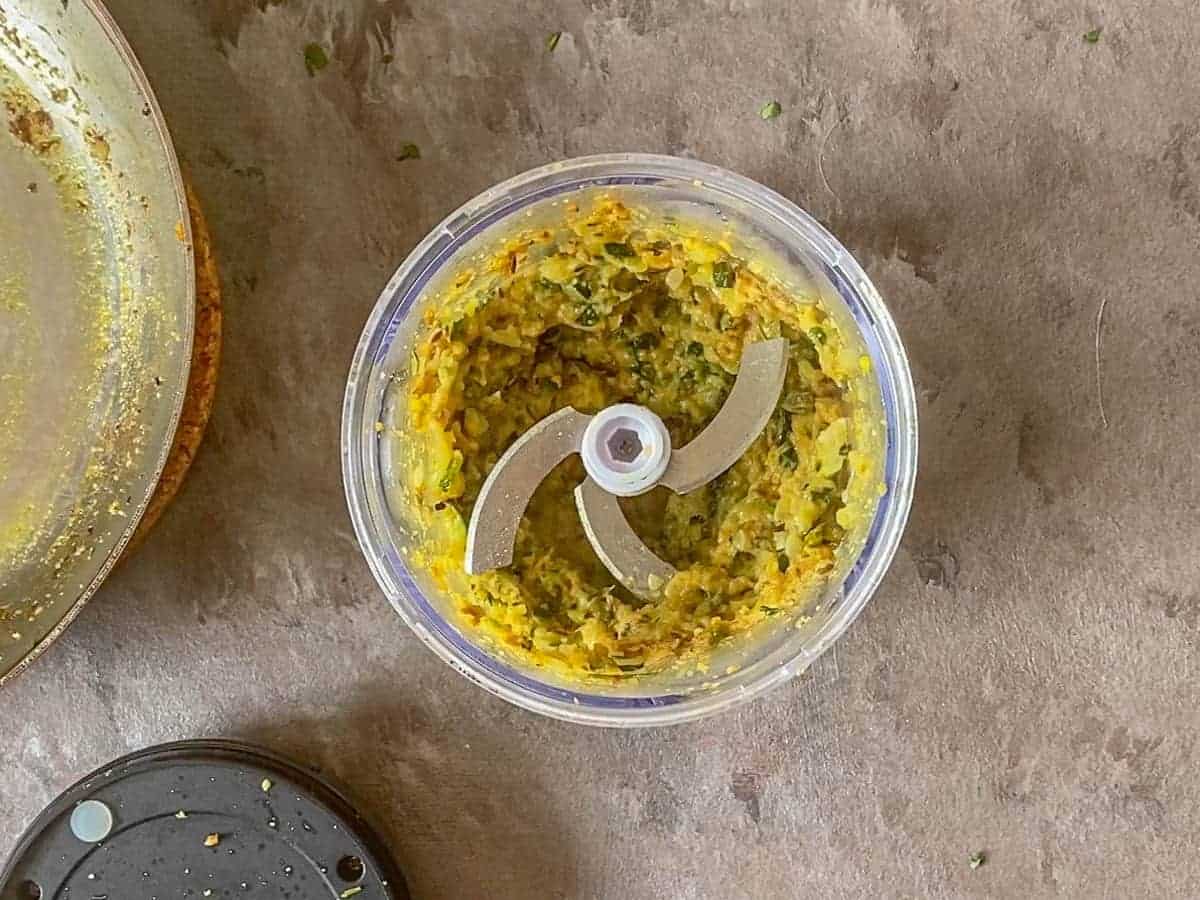
Step 6: Transfer to a food processor, grind to a coarse paste. I prefer keeping it coarse than grinding it to a fine paste.
Serve & Storage
Serve zucchini pachadi with piping hot rice, with dosa or biyyapatlu (instant rice flour dosa) and, as a spread for sandwiches and rolls. Store leftovers in the refrigerator for up to 4-5 days. Serve it cold or at room temperature.

Variation
For a variation, add tomatoes for a zucchini tomato pachadi and depending on how sour the tomatoes are, cut back on tamarind. Substitute zucchini with ridge gourd or ivy gourd (tindora) or even red bell pepper.
Tips
- Color - color of the chutney depends on the chilies used. For a brownish color use more red chilies and for a light color , use more green chilies.
- Food processor - for a coarse texture, use a food processor or a mortar pestle.
- Red chilies and fenugreek seeds do not grind well in a food processor. Hence, first grind these in a spice grinder and then add with the rest of the spice powders during the preparation.
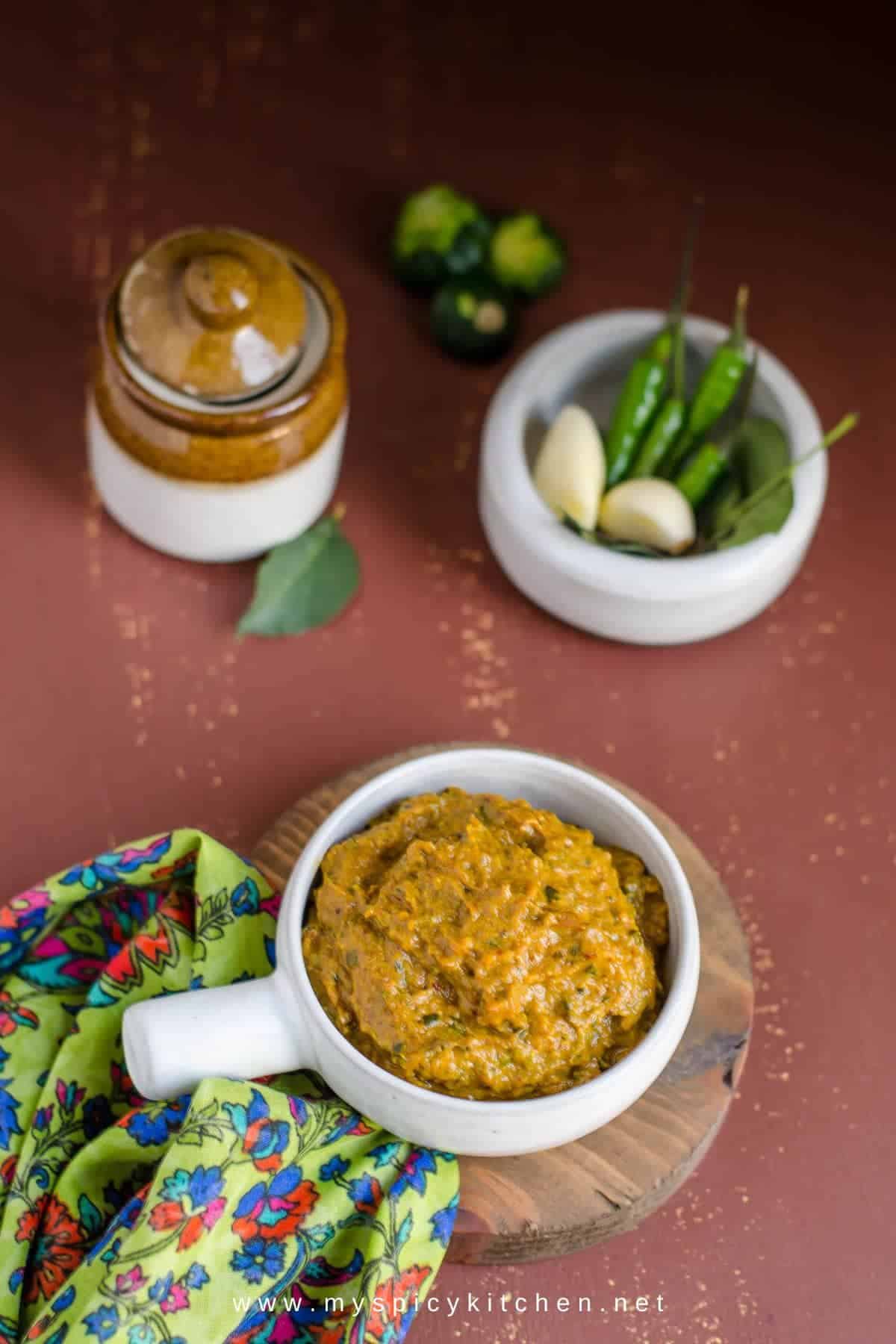
Signup to the newsletter to receive latest updates from MySpicyKitchen.
📖 Recipe

Zucchini Pachadi
Zucchini pachadi is a spicy, tangy Indian chutney, seasoned with Indian chilies, some basic Indian spices and tamarind. A great condiment and a side dish for rice & dosa. It also works great as a spread for sandwiches and rolls.
Print Pin RateServings: 4
Calories: 128kcal
Equipment
1 Knife & Cutting Board
1 Frying pan and mixing spoon
1 Food processor or Indian Mixie or Mortar pestle
1 Spice Grind optional and require it if using a food processor to gring the chutney
Ingredients
- 1½ - 2 tablespoons Oil can use less
- 8-10 Curry Leaves
- 4 small Green Chiles adjust to taste
- 3 big Cloves of Garlic
- 3 Dry Red Chilies
- ½ teaspoon Cumin Seeds
- ½ teaspoon Ground Fenugreek
- ¼ teaspoon Turmeric Powder
- 2 medium Zucchini 360 grams and 3 cups after cutting
- 1 ½ teaspoon Salt adjust to taste
- 1 ½ tablespoons Roasted Sesame Seeds
- 1 tablespoon Roasted Peanuts
- Gooseberry sized Tamarind about 1 heap of or use 1 - 2 tablespoons homemade tamarind paste
- ¼ cup chopped Cilantro | Kotmir
Instructions
Roast sesame seeds and peanuts separately. Cool and make a powder. I always keep roasted sesame and peanuts handy in my pantry as I use these two ingredients a lot in my cooking.
In a spice grinder, grind dry red chilies and fenugreek seeds to powder. This step is optional. Skip this step if using an Indian mixie.. These ingredients do not grind well in US blenders and food processors. Hence I do this additional step.
Heat oil in a pan. Add curry leaves, green chilies, cumin and saute until chilies change color. If using whole dry red chilies (skipped above step), add in this step.
Add garlic, spices powder (red chilies and fenugreek powder), salt, turmeric and stir.
Add zucchini pieces, stir until spices coat the veggies and are lightly roasted.
Add tamarind and give it a good stir. If using tamarind paste or concentrate, add after the zucchini is cooked.
Cover and cook until the zucchini is tender. Zucchini cooks very fast and keep an eye on it.
Remove cover and continue cooking until the mixture is dry. If using tamarind paste or concentrate, add at this step.
Add sesame powder and peanut powder and salt. Stir and turn off the heat.
Let the mixture cool completely and grind to a coarse paste. If necessary add some water. I ground in a food processor as I wanted a coarse texture and did not add any water.
Transfer to a bowl, taste the pachadi and adjust salt. If the chutney is not tangy enough to your taste, add homemade tamarind paste/concentrate to taste. Or add a few drops of lime juice.
Serve chutney with rice, dosa or use as a spread for sandwiches.
Notes
- Food processor - for a coarse texture, use a food processor or a mortar pestle.
- Red chilies and fenugreek seeds do not grind well in a food processor. Hence, first grind these in a spice grinder and then add with the rest of the spice powders during the preparation.
- Color - color of the chutney depends on the chilies used. For a brownish color use more red chilies and for a light color, use more green chilies.
- Variation - For a variation, use tomatoes for a zucchini tomato pachadi and depending on how sour the tomatoes are, cut back on tamarind.
- Substitutions - Substitute zucchini with ridge gourd (turai | beerakaya) or ivy gourd (tindora | dondakaya) or even red bell pepper.
- Sesame & Peanuts - use combination or only sesame seeds. If you do not have sesame seeds, than use only peanuts.
- Nutrition - values mentioned below are approximate values.
Nutrition
Calories: 128kcal | Carbohydrates: 12g | Protein: 3g | Fat: 9g | Saturated Fat: 1g | Polyunsaturated Fat: 3g | Monounsaturated Fat: 4g | Trans Fat: 0.02g | Sodium: 1046mg | Potassium: 424mg | Fiber: 4g | Sugar: 6g | Vitamin A: 664IU | Vitamin C: 112mg | Calcium: 69mg | Iron: 2mg

Source link
